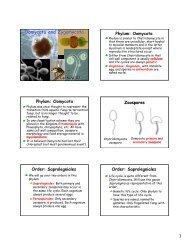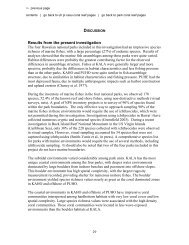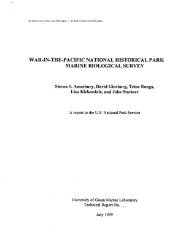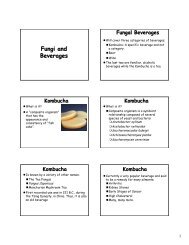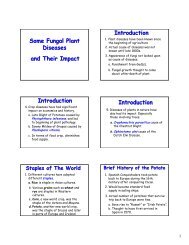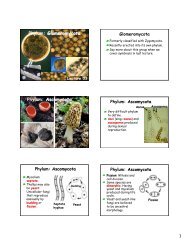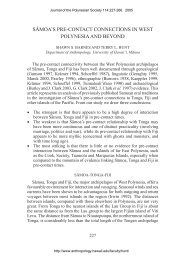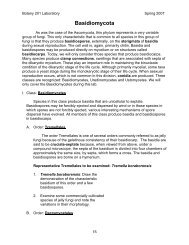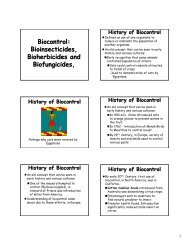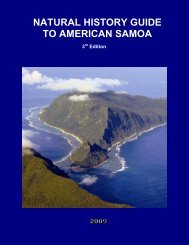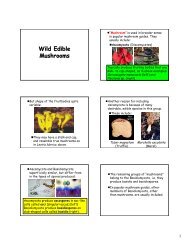american samoa - University of Hawaii at Manoa Botany Department
american samoa - University of Hawaii at Manoa Botany Department
american samoa - University of Hawaii at Manoa Botany Department
- No tags were found...
You also want an ePaper? Increase the reach of your titles
YUMPU automatically turns print PDFs into web optimized ePapers that Google loves.
VEGETATIONNovember 1999 SurveyArt Whistler <strong>of</strong> Isle Botanica conducted a botanical survey <strong>of</strong> the lower Sauino Stream segmenton November 5, 1999. Mr. Whistler was part <strong>of</strong> a three-person field survey team organized byPedersen Planning Consultants th<strong>at</strong> observed wetland veget<strong>at</strong>ion, habit<strong>at</strong> for aqu<strong>at</strong>ic fish andinvertebr<strong>at</strong>es, stream hydrology, as well as land uses within and adjacent to the wetland. Hisobserv<strong>at</strong>ions are summarized in the following paragraphs.The veget<strong>at</strong>ion along the 600-foot Sauino Streamdiffers considerably between the north and southsides <strong>of</strong> the stream channel.Veget<strong>at</strong>ion along the south side <strong>of</strong> the channelcontained maintained grasses such as vaolima(T-grass) and Kyllinga brevifolia. Lesseramounts <strong>of</strong> carpet grass (Axonopus compressus),Alternanthera sessilis, and Kyllinga nemoralis.A smaller banana plant<strong>at</strong>ion was also adjacent tothe south side <strong>of</strong> the channel. None <strong>of</strong> the grassor tree species were oblig<strong>at</strong>e or facult<strong>at</strong>ivewetland plants.The north side <strong>of</strong> the stream channel resembled more <strong>of</strong> a wetland environment. This area wasdomin<strong>at</strong>ed by California grass, Job’s tears, T-grass, and Merremia umbell<strong>at</strong>a. Job’s tears andCalifornia grass are both facult<strong>at</strong>ive wetland species.Veget<strong>at</strong>ion TrendsPrior studies <strong>of</strong> the veget<strong>at</strong>ion <strong>of</strong> along lower Sauino Stream were conducted by BiosystemsAnalysis, Inc. A brief mention was made <strong>of</strong> a “hummocky area” between South PacificTraders (now Laufou Shopping Center) and Lion’s Park.Within a species checklist, botanists noted th<strong>at</strong> the “hummocky area” was domin<strong>at</strong>ed primarilyby vaolima (T-grass) and Merremia umbell<strong>at</strong>a. Drier margins were domin<strong>at</strong>ed by beggar’s-tick(Bidens alba) and a sensitive plant vao fefe (Mimosa pindica). No meaningful correl<strong>at</strong>ion canbe made concerning historical veget<strong>at</strong>ive trends since the more general loc<strong>at</strong>ion <strong>of</strong> the“hummocky area” is not comparable to the more specific stream segment along Sauino Stream.However, it is interesting to note th<strong>at</strong> both vaolima (T-grass) and Merremia umbell<strong>at</strong>a wereidentified by both surveys.In the absence <strong>of</strong> other plantings, the continued maintenance <strong>of</strong> grasses along the south side <strong>of</strong>the 600-foot stream segment will likely maintain the presence <strong>of</strong> existing grasses. The northside <strong>of</strong> the channel may also continue to support California grass and Job’s tears unless bananaplant<strong>at</strong>ions are established. Residential expansion is not expected in light <strong>of</strong> the flood potentialin the vicinity <strong>of</strong> the stream segment.American Samoa Wetlands/Streams Restor<strong>at</strong>ion and Enhancement PlanFebruary 2001, Sauino Stream, Page 8-5



